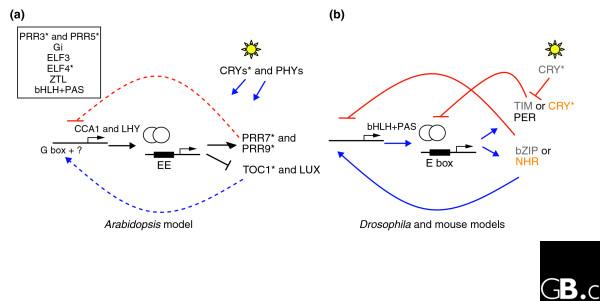Figure 1.

Similarities between the plant, Drosophila and mouse circadian clocks. (a) In Arabidopsis, light perceived through cryptochromes (CRYs) and phytochromes (PHYs) acts to entrain the circadian clock. The Myb-like transcription factors CCA1 and LHY (white circles) bind to the evening element (EE), forming a feedback loop that regulates genes that are thought to positively (blue dashed line) and negatively (red dashed line) regulate the expression of CCA1 and LHY; positive regulation probably occurs through binding of G box and possibly other elements. Forward and reverse genetic screens have identified pioneer genes whose function in the clock still needs to be defined (boxed). (b) In Drosophila and mouse, transcription factors with both bHLH and PAS domains bind the E-box element to regulate positive (blue line) and negative (red line) regulators of their own expression. Fly proteins are indicated in grey and mouse proteins in orange; proteins indicated in black are found in both. The regulators are bZIP type factors in fly and nuclear hormone receptor (NHR) proteins in mouse. In addition, the proteins containing the bHLH and PAS domains also regulate the expression of binding partners that will repress their action. The PER protein acts with TIM in the fly to inhibit the function of the bHLH proteins, whereas it acts with CRY in mouse. In the fly, the CRY protein is a photoreceptor involved in TIM degradation. Proteins marked with an asterisk represent potential clock genes for which homologs were detected in the C. reinhardtii genome sequence.
